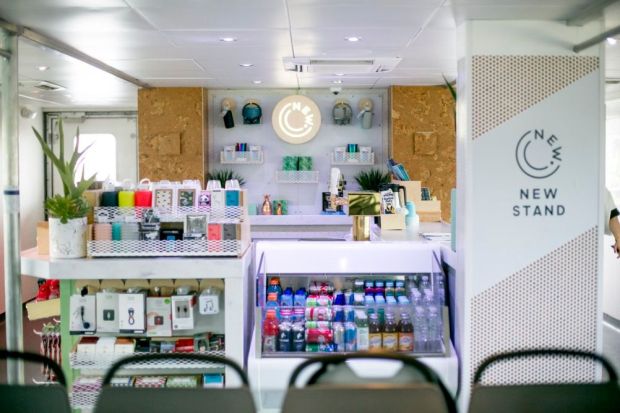Building Better Bodegas For The Modern World

The newsstand of old is one of pop culture’s favorite background players, particularly if that piece of pop culture takes place in New York. When it’s time for some exposition — or for a character to learn that something dramatic about them is out there in the headlines — the newsstand has long been the favored location for those kinds of reveals.
Newsstands have historically served an important role as mini-morning commerce hubs — particularly for urban commuters on the go who use them as a one-stop shop for a newspaper or magazine, hot bagel, cup of coffee and candy bar.
But that role and its relative importance is changing. There are still millions of commuting consumers on the go every morning in Manhattan, of course, as there probably always will be, but those commuters no longer have quite the same needs they had ten years ago. Said simply, almost none of them have a need for a newspaper, magazine or paperback to read on the subway, because they already have a smartphone.
Old-fashioned newsstands and bodegas have stayed around. People still need Snapple and coffee after all, and as this Curbed New York editorialist noted, in many areas they are still serving vital commerce functions in neighborhoods that otherwise lack them.
But the reality is that their numbers have been declining over the last several years, as the cost of rental space in Manhattan has skyrocketed and margins that were always thin have become nonexistent. The small format one-stop shop that newsstands and bodegas represent still garners great affection among New Yorkers, but the business model underlying it is having a harder time sustaining itself. Bodegas may not need to be disrupted, as the Curbed New York editorial argues, but they may need some updating to stay in business.
Which is where the team at The New Stand comes into the story. Two years ago, when various headline writers were bemoaning the death of the bodegas and newsstands of New York, two of The New Stand Co-Founders, George Alan and Lex Kendall, got what they described as “a bee in their bonnet” about how they could make the NYC underground experience a bit more modern and reminiscent of the underground Tokyo scene. Alan and Kendall brought in Andrew Deitchman, who founded the Mother New York ad shop, as CEO — who in turn brought on David Carson — a designer and the founder of Heavy.com.
The New Stand was born as a business concept that invites potential retail shoppers “to imagine if your favorite bodega and favorite blog had a baby.”
Instead of dusty paperbacks, candy bars and bottled drinks, The New Stand’s goal is instead to wire their customers in and provide them with genuinely useful discovery options while they are on the go.
“Half store, half app, New Stand shops carry a rotating mix of coffee, new media, fancy snacks, choice playlists, green juice, cheap art, high fashion, amusing GIFS, weird toys and tons of other interesting things depending on the day,” the site says of its choices on offer.
What The New Stand doesn’t sell is news. They don’t actually carry much in the way of magazines or newspapers, instead using the support app to be the home for curated content that includes aggregated news, product drops and even recommended music releases. Through the same New Stand app, according to the firm, customers can check out of a physical retail location via mobile, as well as gain access to the company’s points-based loyalty program.
The goal is customer convenience and consumer discovery so that the average New Stand shopper can get everything they need — even the things they didn’t know they needed when they first stopped by the kiosk.
The New Stand’s three stationary stores are found underground at NYC transit hubs. In the near future, however, the brand will also install 20 concessions-style 90-square-foot hubs within the New York Ferry system, thanks to a deal inked earlier this year with ferry operator Hornblower Cruises & Events.
“We’re not just a retail company. We’re also a media platform, and part of the partnership with Hornblower is not just concession — we’re in charge of monetizing the boat from a media perspective,” said Andrew Deitchman, who serves as chief executive of the company.
And, in fact, The New Stand’s retail platform is enhanced by the the app’s media business, according to its founders: What the brand stocks on its shelves — an ever-changing assortment of goods — is driven by what app users show particular interest in. And, of course, The New Stand helps push that consumer interest via its consumer-facing platform, which means the company’s revenue is boosted by brand partnerships, which lower prices.
“In many ways, [the New Stand’s approach] is a refresh of the way retail was supposed to be — the concept of partnering with brands,” said Greg Portell, lead partner in the retail practice of A. T. Kearney, a global strategy and management consulting firm, noting that brands need to think of retailers as more than just shelf space. “It’s the responsibility of the products and the brands to be part of the retail story.”
Will The New Stand be the wave of the future for all bodegas of NYC? Probably not. But finding ways to be wired into what consumers need — even when that changes — and being able to offer it to them on the go? Well, it might just be the future of how a lot of smaller format stores stay relevant with their customer bases.
